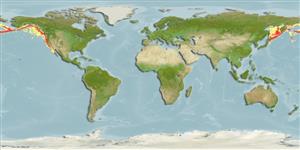>
Gadiformes (Cods) >
Macrouridae (Grenadiers or rattails)
Etymology: Albatrossia: The name of an oceanographic ship "Albatross" (1888-1900) (Ref. 45335); pectoralis: pectoralis refering to the long and narrow pectoral fin (Ref. 6885).
More on author: Gilbert.
Environment: milieu / climate zone / depth range / distribution range
Ecologie
marien bathydemersaal; standvastig; diepte 140 - 3500 m (Ref. 50550), usually 700 - 1100 m (Ref. 56476). Deep-water; 62°N - 26°N, 143°E - 115°W (Ref. 1371)
North Pacific: northern Japan to the Okhotsk and Bering seas, east to the Gulf of Alaska, south to northern Baja California in Mexico.
Lengte bij maturiteit / Grootte / Gewicht / Leeftijd
Maturity: Lm 83.2, range 65 - 102 cm
Max length : 210 cm TL mannelijk / geslacht onbekend; (Ref. 56527); common length : 85.0 cm mannelijk / geslacht onbekend; (Ref. 56527); max. gepubliceerd gewicht: 86.0 kg (Ref. 56527); max. gerapporteerde leeftijd: 56 Jaren (Ref. 39270)
Korte beschrijving
Morfologie | Morfometrie
Dorsale stekels (totaal): 2; Dorsale zachte stralen (totaal): 7-9; Anale stekels 0; Anale zachte stralen: 131. Snout low, slightly protruding beyond the large mouth, without a spinous terminal scute. Scales small, slightly oblong, with moderate-sized median ridge, without spines or with few weak spinules, and 0 to 5 much lower, non-spinulated ridges laterally on exposed field. Swim bladder small, with 2 retia mirabilia. Gray-brown on head and body, each scale with a prominent dark posterior border, fins and lateral line darker; black in mouth, gill cavity, and on peritoneum (Ref. 6885). Branchiostegal rays: 6-6; pyloric caeca: 12-16;
Young apparently bathypelagic to some degree but become bathydemersal at a size of 50-60 cm (Ref. 1371). Adults feed mainly on cephalopods, fish and shrimps; other food items include ctenophores, echinoderms, worms, crabs, and amphipods (Ref. 1371). Oviparous, with planktonic larvae (Ref. 36385).
Cohen, D.M., T. Inada, T. Iwamoto and N. Scialabba, 1990. FAO species catalogue. Vol. 10. Gadiform fishes of the world (Order Gadiformes). An annotated and illustrated catalogue of cods, hakes, grenadiers and other gadiform fishes known to date. FAO Fish. Synop. 125(10). Rome: FAO. 442 p. (Ref. 1371)
Status op de Rode Lijst van het IUCN (Ref. 130435)
Gevaar voor de mens
Harmless
Gebruik door de mens
Visserij: commercieel
Meer informatie
ReferentiesAquacultuurAquacultuurprofielKweeklijnenGeneticaElectrophoresesErfelijkheidZiektesVerwerkingNutrientsMassaconversie
Tools
Speciale rapporten
Download XML
Internetbronnen
Estimates based on models
Preferred temperature (Ref.
123201): 2.2 - 3.5, mean 2.6 °C (based on 120 cells).
Fylogenetische diversiteitsindex (Ref.
82804): PD
50 = 1.0000 [Uniqueness, from 0.5 = low to 2.0 = high].
Bayesian length-weight: a=0.00087 (0.00057 - 0.00133), b=3.26 (3.13 - 3.39), in cm total length, based on LWR estimates for this species & (Sub)family-body (Ref.
93245).
Trofisch niveau (Ref.
69278): 4.3 ±0.7 se; based on diet studies.
Weerstandsvermogen (Ref.
120179): Zeer laag, minimale populatieverdubbelingstijd meer dan 14 jaar (tmax >30).
Fishing Vulnerability (Ref.
59153): High to very high vulnerability (70 of 100).
Nutrients (Ref.
124155): Calcium = 10.4 [5.3, 23.0] mg/100g; Iron = 0.303 [0.155, 0.627] mg/100g; Protein = 17.2 [15.5, 18.9] %; Omega3 = 0.226 [0.101, 0.496] g/100g; Selenium = 41 [17, 98] μg/100g; VitaminA = 4.24 [0.83, 19.44] μg/100g; Zinc = 0.232 [0.151, 0.366] mg/100g (wet weight);
